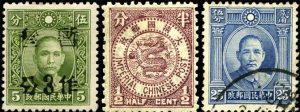
Stamp collecting has been around for a long time. The first known stamp collector is recorded as early as 1774 in Ireland. The concept began to catch on over the next century, spreading through Britain, the United States and the rest of the world. Perhaps it comes as no surprise that China has discovered a fascination with the hobby. An estimated one third of today’s philatelists (stamp collectors) are believed to reside there. Why has this hobby caught on in China and how is the sudden explosion affecting stamp values?
Stamp Collecting for Social Status
Stamp collecting grew in popularity in the U.S. during the Great Depression. It was an inexpensive way to pass the time during a period when poverty loomed over the country. Today, it is still a fun pastime enjoyed by thousands of people throughout the country who love finding new gems to add to their collection. In China, however, opinions on stamp collecting are very different. Stamp collecting is held in high regard for all ages. It is considered a symbol of middle to upper class social status. Those who do it are viewed as people of greater respectability with a scholarly nature.
The Rise of Stamp Collecting in China
The rise of stamp collecting in China wasn’t an accident. In fact, the growth of philately was quite intentional. The Chinese government orchestrated the increase in popularity by fostering a desire in young people throughout the country. Elementary and high school teachers were encouraged to organize stamp collecting clubs in an effort to draw interest to national history. China’s stamps often feature images of historical events or people, which brings to mind the past and inspires a desire to learn more.
Chinese Collectors & Shifting Stamp Prices
Chinese investors were looking for a way to diversify their portfolios. One way was by investing in treasure assets, which included items like rare coins, paintings, classic cars, and of course, stamps. A tangible asset without a set price allows investors to avoid financial repression while also taking advantage of less strict taxation laws.
According to managing director at Intelligent Partnership Guy Tolhurst: “As tangible assets, they present investors with one way to beat financial repression; the low interest rates, money printing and silent currency wars that our central banks are resorting to in order to stimulate the economy.” He went on to state that “they can be a hedge against, and protection from, inflation, devalued currencies and punitive taxes.”
So why have stamp price increases slowed over the last year despite Chinese interest and investment? Ireland-based fine art agent William Hanbury-Tenison said that government economic stimulus is what caused the massive price rise of stamps over the last few years. He explained that Chinese banks were ordered to lend funds and that “business people paid commissions to bankers or go-betweens to get loans and you get enormous amounts of money in the hands of an elite who could broker distributions of liquidity. They spent it on luxuries.”
Today, things have changed, and the Chinese financing has funneled out of the stamp market. This has caused a sales slowdown with values stabilizing across the globe.
The Future of Stamp Collecting
Devoted stamp collectors should not worry too much. The future will likely hold another peak for the market. Stanley Gibbons’ head of investment Keith Heddle reports that “you get ten year cycles, and you do get rises, then a few years of flattening, and then prices rise rapidly again.” Whether we ever experience the rapid price increases again which saw high end stamps double or tripled in price in a year remains to be seen but with new money entering the markets and several economies showing extreme growth anything is possible.
Where does one find buyers for Chinese stamps?